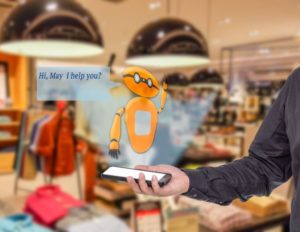Chatbot trends to boost sales and the Customer Experience.
What is hotter than bots right now? There is so much hype around chatbots and even more confusion, that’s why

Scurri have put together this guide to top trends for chatbots for retailers to simplify the conversation about chat.
Customer experience is the battleground that retailers are competing on, with CX being named as the key differentiator and the number one factor when it comes to brand loyalty above price and product. The customer journey can be complex and it’s a serious challenge to improve the customer experience across all touchpoints. Only 13% of brands rate their CX at 9/10. (Hubspot)
Consumers expect Personalisation as part of the shopping experience, and research shows that consumers spend 48% more when their experience is personalised. (Impact) And 80% of customers are more likely to make a purchase when they’re offered a personalised customer experience. (Epsilon)
What personalisation means to shoppers is customised recommendations, helpful customer service, relevant offers and discounts and convenience. Guess what! Chatbots can be used across all these areas to boost CX by offering personalised assistance based on preferences, quickly & efficiently.
Why bot? Why not?
There are so many ways chatbots can benefit your webstore.
- Streamline customer service 24/7

- Virtual Assistants and conversational marketing
- Reduce cart abandonment and returns
- Efficient analytics
With so much potential for increased revenue, why wouldn’t you employ chatbots? The most commonly presented stat about chatbots we see is that by 2020, 85% of consumers will engage with businesses without ever interacting with another human being. (Gartner) But let’s not forget that ultimately the aim is to drive better interactions with people.
Consumers are already present on websites, mobile, and messenger apps, using chatbot software to interact with them on these platforms is an ideal way to interact with an active audience.
Chatbots to boost Customer Service.
Consumers expect enquires to be answered immediately and for issues to be resolved quickly, they are less tolerant about delays than ever. Implementing AI and chatbots is an efficient way to automate common queries and answer customers fast and of course, cutting down the amount of time humans spend on repetitive tasks is cost-effective.
Bots can be used harmoniously alongside human agents. Having a portion of the customer support service housed within a data centre can help keep that function going when staff are occupied during busy periods or at night when they’re off duty.
AI can be used to augment customer service agents by equipping them with tools and data to help them help customers faster and more efficiently. Having the combination of humans and bots means that if a consumer asks specifically to be put in touch with a real person they can easily make the switch and not get frustrated.
Different chatbot apps have varying degrees of sophistication but rule-based bots are simple to program for situations that have a limited number of questions and a limited number of answers.
Virtual Assistants.
There are more advanced types of bots that use AI to learn and adapt which are becoming more widespread as the technology becomes more available. Virtual assistants are geared more towards new shopping behaviours and have the potential to be a new revenue stream. Stores with a wide variety of products and more up/cross-sell opportunities would benefit most from Virtual Assistants which are relatively easy to build.
Virtual assistants can recommend products, inform users of offers and incentives to upsell and increase order value. You can even build different bots for the same website to interact under different categories, personalising the experience more by acting as a virtual sales assistant, offering helpful suggestions to the shopper.
Companies are investing a lot of money into Natural Language Processing, a branch of AI, in an effort to push chatbots towards a point where they can understand complex requests and better understand user enquires. There are varying reports of the current level of sophistication but already many people interact with bots without knowing it. NLP could advance to a point in the next 10 years where chatbots and are indistinguishable from online human chats.
Brands that Botify beautifully.
Some brands are getting highly creative with their deployment of chatbots and virtual assistants in order to convert more sales. Beauty brand Sephora had a very specific goal to boost engagement with Gen Z’s in the run-up to Prom. Their approach was to combine their chatbot, which was providing tips, inspiration and style content with a series of Facebook Live sessions featuring an influencer.
Users were asked to submit their beauty questions ahead of the live stream and when the feed concluded they were directed back to the bot for more content. This resulted in 600k chatbot interactions and 107k facebook live viewers during this period. The brand used the combination of technologies to engage in real-time in an authentic way that was highly relevant to their users.
eBay Shopbot interacts by asking relevant questions about what you want then searches the millions of listings to help you find the to find the perfect fit, style and colour for you.
Burberry’s chatbot suggests recommendations to users and helps them find matching items and accessories, it’s also integrated with Uber to help customers come directly to the store.
Vichy’s use of chatbots resulted in a 35% increase in average revenue per user and 4 times longer online sessions.
Cart abandonment and Returns.
Chatbots can be used effectively to counter cart abandonment by being in the right place at the right time to answer queries, provide extra information and offer help at the point the shopper is about to leave the page. In the case of abandoned carts we know that follow up emails are an effective way to reengage with customers, chatbots can remind shoppers of their basket or even notify them of offers in their inbox.
Answering customer queries before purchase and ensuring the customer gets what they need can even reduce the rate of returns which we know is a major cost to online retailers.
The benefits are clear.
AI, chatbots and Virtual Assistants have the potential to boost engagement at every stage of the customer journey, allowing retailers to drive a higher number and higher quality interactions at scale and increase conversion.
Analysing data from customer conversations to gain vital insights can be used to improve operations as well as the CX by tackling issues that continuously arise.
The technology is at our fingertips.
The smart approach to chatbots would be to identify the weak link in your customer journey and test out chatbots in that area for starters. Use a dedicated team to implement the technology, measure the results and refine the process before rolling it out across all touchpoints. Be strategic and focused.
With giants like Google, Apple, Microsoft and Amazon at the forefront, this technology is constantly improving, becoming more widespread and easier to implement.













